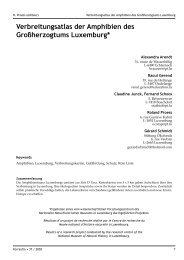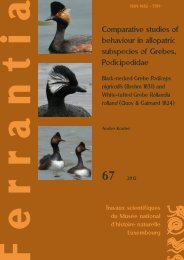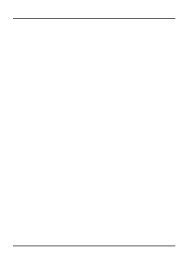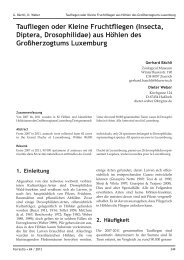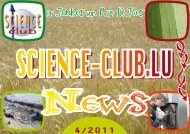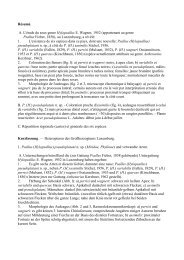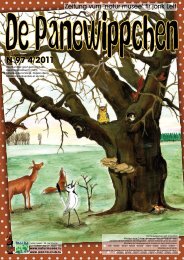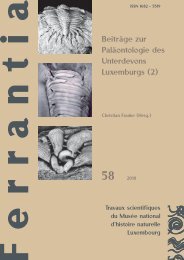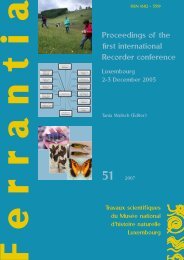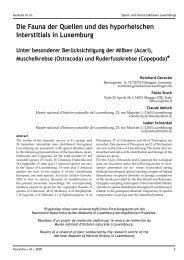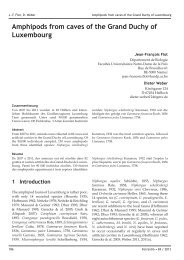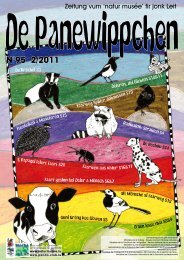Publi.complète - Musée national d'histoire naturelle
Publi.complète - Musée national d'histoire naturelle
Publi.complète - Musée national d'histoire naturelle
You also want an ePaper? Increase the reach of your titles
YUMPU automatically turns print PDFs into web optimized ePapers that Google loves.
InStRuCtIOnS tO AutHORS<br />
Please check our internet site http://www.mnhn.lu for<br />
the latest version of these instructions!<br />
Scope<br />
FERRANTIA is a series of monographic works (20-250<br />
pages in final layout) dealing with life and earth sciences,<br />
preferably related in some way or other to the Grand-<br />
Duchy of Luxembourg.<br />
It publishes original results of botanical, zoological,<br />
ecological, geological, mineralogical, paleontological,<br />
geophysical and astrophysical research and related<br />
fields.<br />
A complete issue of FERRANTIA may be devoted to<br />
several papers on a single topic as the responsibility of<br />
an invited editor.<br />
Copyright<br />
The submission of a manuscript to FERRANTIA implies<br />
that the paper must not have been accepted for publication<br />
or be under consideration elsewhere.<br />
Copyright of a published paper, including illustrations,<br />
becomes the property of the publisher. Requests<br />
to reproduce material from FERRANTIA should be<br />
addressed to the editor.<br />
Reviewing<br />
Articles submitted for publication are reviewed by the<br />
editorial board and by one or two referees. The final<br />
decision on acceptance or rejection of the manuscript is<br />
taken by the editorial board. Manuscripts not prepared<br />
according to the following instructions to authors will be<br />
returned for correction prior to review.<br />
nomenclature<br />
Papers with a systematic content should strictly follow<br />
the Inter<strong>national</strong> Codes of Nomenclature.<br />
Specimens<br />
We recommend that the authors should deposit at least a<br />
part of the type material in the MNHN collections.<br />
<strong>Publi</strong>cation dates<br />
FERRANTIA pays special attention to publication dates,<br />
which are always specified to the day of publication.<br />
Manuscripts<br />
Manuscripts, without limitation of the number of pages,<br />
must conform strictly to the instructions to authors, and<br />
should be sent to the Editor:<br />
FERRANTIA<br />
Travaux scientifiques du <strong>Musée</strong> <strong>national</strong> <strong>d'histoire</strong><br />
<strong>naturelle</strong> de Luxembourg<br />
25, rue Munster<br />
L-2160 Luxembourg<br />
Format<br />
Manuscripts must be submitted as paper copy in triplicate<br />
in A4 format, preferably double-spaced, with<br />
margins of at least 3 cm and all pages numbered.<br />
If possible, an electronic version of the text may also be<br />
sent as unformatted Word document (PC or MAC) (font<br />
Times New Roman, 10 pt). Tables (Word, Excel) and<br />
figures (300 dpi in the page size of the journal) may also<br />
be sent electronically.<br />
Structure<br />
Papers are to be written in simple, correct and concise<br />
French, German or English. They should be organized<br />
as follows:<br />
- a brief title (should not include the name of new taxa);<br />
- a suggested running head (no more than 50 characters);<br />
- name(s) and first name(s) of author(s), followed by<br />
their full address(es) and, if possible, e-mail or fax<br />
number;<br />
- abstracts in English, French and German, each 200-800<br />
words long; new taxa names should be included in the<br />
abstract; the abstract should be precise and descriptive,<br />
in order to be reproduced as such in data bases;<br />
avoid vague sentences such as "three new species are<br />
described" or "species are compared to species already<br />
known"; include precise differential characters;<br />
- text of the article, in the following order: Introduction,<br />
Abbreviations used, Material and methods, Results<br />
and/or Observations, Discussion, Acknowledgements,<br />
References. The arrangement of the parts "Results/<br />
Observations" and "Discussion" may be modulated<br />
according to the length and subject of the article; very<br />
long papers may include a table of contents;<br />
- for systematic descriptions, each description should<br />
follow the order: name of taxon with author and<br />
date, synonymy, type material, etymology, material<br />
examined, distribution, diagnosis and/or description,<br />
remarks.<br />
- description of geological features should include type<br />
level, type horizon, type locality. This order may be<br />
adapted according to the concerned groups: consult a<br />
recent issue of FERRANTIA;<br />
- taxon names must be stated with author (and publication<br />
date, separated by a comma, where appropriate) at<br />
least once at the first mention. At subsequent mentions<br />
Ferrantia • 63 / 2011



